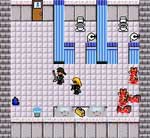Wired:
When you actually get to the school and begin the attack, things become subtler yet. As you wander through the hallways, the little pixilated victims scurry around in semi-random paths, and any time you cross paths a battle is triggered. You encounter the same six or seven kids over and over again: the “Jock Type,” the “Preppy Girl,” the “Sheltered Girl”, the “Preppy Boy.”
It’s a neat stab at the mindset of the killers, who, for all their bombast about being objectified by their tormentors, did precisely the same thing to their victims. They didn’t see them as individuals: They were just metaphoric targets for their hatred. Indeed, in the game, as the killers did in real life, you don’t target any particular kids. You just wander around killing randomly. And Ledonne’s aesthetic decision to make Super Columbine so retro-looking enhances this effect: The game’s style evokes the killer’s pared-down, simplistic, self-serving view of the world.
Ledonne also gets in a few sly jabs at video-game culture itself. When you acquire your weapons, the game announces it with the sort of cheery dialog box that is typical in an RPG: “You acquire a Fire Spell! You pick up a Frag Grenade!” Except here, because the weapons are drawn from real life (“Eric got a Hi-Point model 996 carbine rifle complete with shoulder strap!”), the exuberant tone highlights just how psychotic and disconnected from reality the conventions of video games can sometimes seem.
Here.

